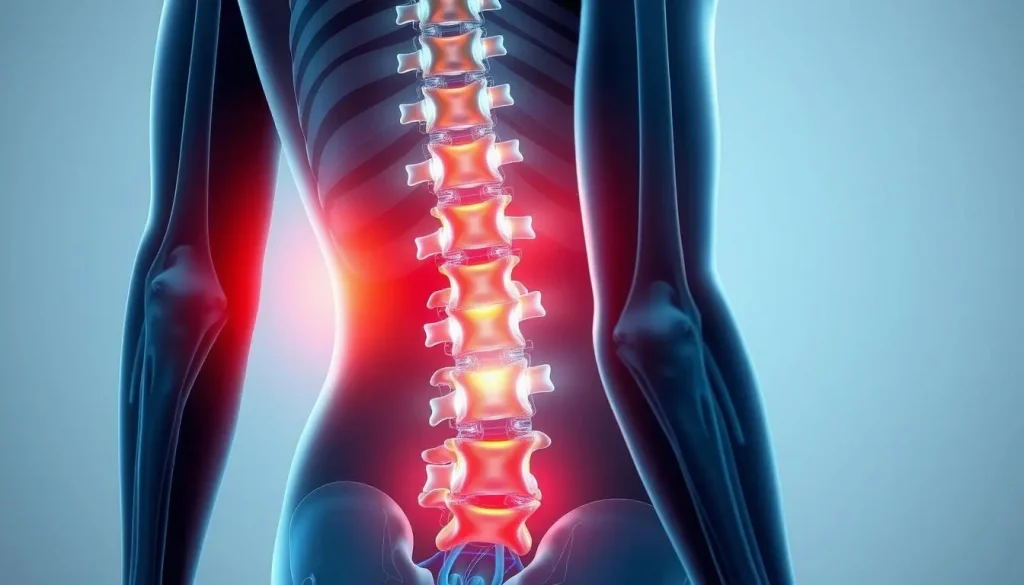What if your lower back pain is more than just a simple strain from lifting? With numerous potential causes, how can you distinguish between a minor issue and a condition that needs urgent medical attention?
Lower back pain differential diagnosis is a crucial yet challenging task for healthcare providers. It involves differentiating between common musculoskeletal problems and more serious, potentially life-threatening conditions. Considering that 50-80% of people experience lower back pain at some point, an accurate diagnosis is essential. This issue also comes at a high cost, with annual expenses related to treatment and lost productivity reaching up to $100 billion.
Most cases are simple muscle strains or herniated discs. But these can be mistaken for more serious problems like nerve damage or spinal narrowing. Without the right diagnosis, treatment might miss important steps for serious conditions. Doctors must look for specific signs to tell these apart.
Doctors also need to know the anatomy of the lower back well. This knowledge is important during physical exams.
So, what steps should doctors take to avoid missing serious conditions? Keep reading to learn more about diagnosing lower back pain.

A detailed anatomical illustration of the human lower back, highlighting various potential causes of pain such as herniated discs, muscle strains, spinal stenosis, and sciatica. Include a color-coded system to differentiate each condition, with arrows indicating nerve pathways and affected muscles. The background should be neutral to emphasize the anatomical structures and conditions.
Key Takeaways
- Lower back pain affects 50-80% of the population during their lifetime.
- The annual cost of lower back pain is approximately $100 billion.
- 90% of lower back pain cases revolve within a year, but accurate diagnosis is crucial for the remaining 10%.
- Common back pain issues include muscle strain, lumbar disc herniation, and spinal stenosis.
- Understanding clinical neuroanatomy is vital for differentiating between serious and nonspecific lower back pain.
Introduction to Lower Back Pain
Lower back pain is a common problem that affects many people. It's found in 7.5% of the population at any given time. Over 80% of people will experience it at some point in their lives. This condition leads to high healthcare costs and causes people to miss work.
There are several reasons why people get lower back pain. Muscle strains, herniated discs, and spinal stenosis are some causes. Activities like squats can also make it worse, leading to pain in the lower back. Knowing what triggers this pain is key, which is why a lower back pain locator is important.
Obesity, smoking, and job dissatisfaction can also increase the risk of lower back pain. This makes it crucial to understand and tackle these factors.
Dealing with lower back pain requires a broad approach. It's one of the top reasons people visit emergency rooms. Doctors see patients with this issue almost every week. For those with chronic pain, lasting more than 12 weeks, the situation is more complex.

A detailed anatomical illustration of the human lower back, highlighting specific areas of pain with color-coded zones, surrounded by abstract representations of common causes such as muscle strain, herniated discs, and sciatica. The background should be a soft gradient to enhance focus on the lower back area, with a subtle representation of nerve pathways and muscle structures integrated into the design.
The financial impact of chronic lower back pain is huge, costing between $12.2 billion and $90.6 billion each year. Evaluating this pain involves looking at both physical and mental health issues. Treatments like painkillers, acupuncture, and rehabilitation programs can help a lot.
Guidelines for managing lower back pain suggest a mix of treatments. This includes exercise, yoga, medication, and spinal therapy.
New ways to treat lower back pain are being developed all the time. These aim to improve the lives of those suffering. A comprehensive approach is needed to tackle the many causes and symptoms of lower back pain.
Common Causes of Lower Back Pain
Lower back pain affects millions in the U.S. each year. Knowing what causes it is key to treating it. Vertebrogenic pain, listed as m54.51, is a common reason for lower back pain. Let's explore some of the main causes of vertebrogenic low back pain icd 10.

Anatomical illustration of the human spine highlighting vertebral structures, with emphasis on lumbar vertebrae, surrounding muscles, and nerves, showcasing areas of pain through color gradients, artistic representation of inflammation and tension in lower back, subtle background depicting a calm and soothing environment.
Muscle Strain and Disc Herniation
Muscle strains and disc herniations are common causes of lower back pain. They often come from injuries or too much use. Muscle strains happen when muscles or tendons get torn or stretched too far, causing pain and stiffness.
Disc herniation, or a slipped disc, happens when the soft part of a spinal disc bulges out. This can press on nerves, causing pain and weakness. But, only about 2% of people with back pain have a herniated disc.
Spinal Stenosis and Lumbar Radiculopathy
Spinal stenosis and lumbar radiculopathy can really affect your life. Spinal stenosis is when the spinal canal gets narrower, pressing on nerves. It's more common in people over 50 and can cause pain, numbness, and weakness.
Lumbar radiculopathy happens when nerves in the lower back get compressed or irritated. This can cause pain, weakness, and changes in feeling along the nerve path.
For vertebrogenic pain, MRI or CT scans are very helpful. They show detailed images of soft tissues and bones. Knowing these causes helps manage vertebrogenic low back pain icd 10 better.
Red Flags and Serious Causes of Back Pain
It's crucial to know the warning signs of back pain. These signs help tell if the pain is just a minor issue or something more serious. When someone says "my lower back burns and hurts," it's important to check for these red flags. This can lead to the right treatment at the right time, helping the patient get better faster.
Neoplasia and Infections
Back pain from tumors or infections can seem like regular back pain at first. But, they need quick attention because they can be very serious. Look out for pain that doesn't go away, losing weight without trying, and night sweats for tumors. For infections, watch for fever, chills, and sore spots that don't feel right.
- Neoplasia: Spinal tumors are rare but serious. They cause bad pain and can hurt nerves. MRI scans are often needed to find them.
- Infections: Spinal infections like discitis and osteomyelitis cause pain, fever, and high inflammation. Quick antibiotics are key.
Cauda Equina Syndrome
Cauda equina syndrome is a rare but serious issue that needs quick action. It causes intense back pain, leg pain, and problems with the bladder and bowel. If not treated fast, it can cause permanent nerve damage.
Checking the body carefully and getting images fast is vital. This helps find the cause of "my lower back burns and hurts." It makes sure the right treatment starts quickly, avoiding long-term problems.
| Condition | Key Symptoms | Diagnostic Tools | Treatment |
|---|---|---|---|
| Neoplasia | Persistent pain, weight loss, night sweats | MRI, CT scan, biopsy | Surgery, radiation, chemotherapy |
| Infections | Fever, localized tenderness, chills | Blood tests, MRI, bone scans | Antibiotic therapy |
| Cauda Equina Syndrome | Bowel/bladder dysfunction, saddle anesthesia | MRI, urgent clinical assessment | Emergency surgery |
Using a detailed check-up and understanding the back pain chart can help spot serious issues. Quick and accurate diagnosis is crucial for treating these serious conditions well.
Clinical Presentation and Symptoms
Understanding lower back pain is key to getting the right treatment. This pain can show up in many ways. Knowing the differences is important.
Up to 84 percent of adults have low back pain at some point. About 75-85% of Americans will face it at some time. Spotting the right symptoms helps in giving the right care.
Mechanical vs. Systemic Pain
It's vital to tell mechanical from systemic pain when diagnosing back problems. Mechanical pain comes from muscle strain or disc issues. It makes moving hard and hurts to stand up straight.
Systemic pain might signal a bigger issue like an infection. This pain spreads out and doesn't always respond to usual treatments.
Radicular and Referred Pain
Radicular pain happens when a nerve in the spine gets hurt. It causes sharp pain that shoots down the leg, known as sciatica. This pain can also bring tingling or numbness.
Referred pain feels like it's coming from somewhere else. For example, back pain might feel like it's in the buttocks or thighs. Knowing these types helps doctors find the right treatment, helping patients feel better faster.
40% of people with back pain first see a primary care doctor. Another 40% go to chiropractors. A team effort often works best for patients. In 90% of cases, back pain gets better without surgery. But those with chronic pain lasting over 12 weeks need to explore different treatments.
Medicare Finalizes Decision to Cover Acupuncture for Chronic Low Back Pain (M54.51)
FAQ
What is lower back pain differential diagnosis?
Lower back pain differential diagnosis is about finding the cause of back pain. It looks at muscle strain, disc herniation, spinal stenosis, and lumbar radiculopathy.
How do you use a lower back pain locator?
A lower back pain locator helps pinpoint where the pain is. It uses symptoms and physical checks to map the pain.
Why does my lower back hurt after squats?
Squats can hurt your back due to muscle strain or bad form. It's important to use the right technique and rest to avoid and treat the pain.
What is vertebrogenic pain?
Vertebrogenic pain comes from the vertebrae or spinal bones. It's often linked to vertebral fractures or spine degeneration.
What does the ICD-10 code M54.51 signify?
The ICD-10 code M54.51 means the back pain is from vertebrae issues. It points to problems within the vertebrae.
What are the primary causes of muscle strain and disc herniation?
Muscle strains come from injury or overuse. Disc herniations are often from trauma or spine degeneration.
What are the symptoms of spinal stenosis and lumbar radiculopathy?
Spinal stenosis causes pain, numbness, or weakness in the back and legs. Lumbar radiculopathy is sharp pain down the leg from nerve compression.
What are red flags in back pain indicating serious underlying conditions?
Red flags include severe pain, unexplained weight loss, fever, or neurological symptoms. These may signal serious issues like neoplasia, infections, or cauda equina syndrome.
How do neoplasia and spinal infections manifest in back pain?
Neoplasia and spinal infections cause persistent, severe back pain. They may also bring fever or weight loss. Quick medical check-up is needed.
What is cauda equina syndrome?
Cauda equina syndrome is a serious condition. It causes severe back pain, loss of bladder or bowel control, and leg weakness. It's due to nerve compression at the spine's base.
What distinguishes mechanical back pain from systemic pain?
Mechanical back pain is from musculoskeletal issues and gets better with rest. Systemic pain suggests underlying conditions like infections or autoimmune diseases.
What are the clinical implications of radicular and referred pain?
Radicular pain comes from nerve root irritation and follows nerve paths. Referred pain is felt in areas not where the pain is. Accurate diagnosis is key for effective treatment.
Why does it hurt to stand up straight with lower back pain?
Standing straight can hurt due to muscle imbalance, disc problems, or conditions like spinal stenosis. These issues get worse when the spine extends.





